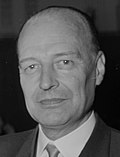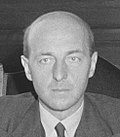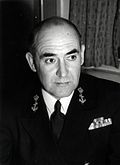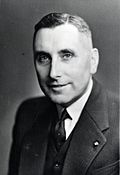Third Drees cabinet
Third Drees cabinet Fourth Drees cabinet | |
|---|---|
46th Cabinet of the Netherlands | |
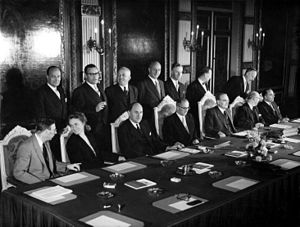  The first meeting of the incoming Third Drees cabinet on 12 October 1956 | |
| Date formed | 13 October 1956 |
| Date dissolved | 22 December 1958 (Demissionary from 11 December 1958) |
| People and organisations | |
| Head of state | Queen Juliana |
| Head of government | Willem Drees |
| Deputy head of government | Teun Struycken |
| No. of ministers | 14 |
| Ministers removed | 2 |
| Total no. of members | 16 |
| Member party | Labour Party (PvdA) Catholic People's Party (KVP) Anti-Revolutionary Party (ARP) Christian Historical Union (CHU) |
| Status in legislature | Grand coalition (Roman/Red) |
| Opposition party | People's Party for Freedom and Democracy |
| Opposition leader | Pieter Oud |
| History | |
| Election | 1956 election |
| Outgoing election | 1959 election |
| Legislature terms | 1956–59 |
| Incoming formation | 1956 formation |
| Outgoing formation | 1958 formation |
| Predecessor | Second Drees cabinet |
| Successor | Second Beel cabinet |
| Part of the Politics series |
![Azure, billetty Or a lion with a coronet Or armed and langued Gules holding in his dexter paw a sword Argent hilted Or and in the sinister paw seven arrows Argent pointed and bound together Or. [The seven arrows stand for the seven provinces of the Union of Utrecht.] The shield is crowned with the (Dutch) royal crown and supported by two lions Or armed and langued gules. They stand on a scroll Azure with the text (Or) "Je Maintiendrai" (French for "I will maintain".)](http://upload.wikimedia.org/wikipedia/commons/thumb/8/8f/State_coat_of_arms_of_the_Netherlands.svg/150px-State_coat_of_arms_of_the_Netherlands.svg.png) |
|---|
|
|
The Third Drees cabinet, also called the Fourth Drees cabinet[1] was the cabinet of the Netherlands from 13 October 1956 until 22 December 1958. The cabinet was formed by the political parties Labour Party (PvdA), Catholic People's Party (KVP), Anti-Revolutionary Party (ARP) and the Christian Historical Union (CHU) after the election of 1956. The grand coalition (Roman/Red) cabinet was a majority cabinet in the House of Representatives.[2]
Formation
The cabinet formation took 4 months. This was the longest and most difficult formation the Netherlands had ever seen, partly as a result of the rising tensions between the Labour Party and the Catholic People's Party. Also after the formation, these tensions kept rising, leading to the fall of the cabinet in December 1958. Root of the tensions were the decision of the Roman Catholic Church to excommunicate Catholic socialists from the church. Nearly 100% of the south of the Netherlands used to vote for the Catholic People's Party for decades, but in the 1950s secular political parties got an increase in votes. The excommunication had the result of social exclusion in cities and villages which used to be solidly Catholic blocks. Protestants in the north supported the Catholics.
Term
After considerable growth after World War II, the rising wages, combined with lowered taxes, now led to overspending, which endangered the export. In reaction, wages and government spending were both lowered.
Rising tension with Indonesia, mostly about New Guinea, came to a climax when Indonesia nationalised Dutch properties in the country. The Dutch were supposed to leave entirely.
Other international problems were the Suez Crisis and the Hungarian revolt, which led to monetary and economic problems. The threat of an oil crisis as a result of the Suez crisis led to the installation of car-free Sundays. The suppression of the Hungarian revolution by the USSR led to plundering of communist institutions. Several thousands of Hungarian refugees were accepted into the Netherlands and welcomed in Dutch homes.
On 1 January 1957, the state pension AOW after the age of 65, that was proposed during the former cabinet Drees II, was installed. This resulted from a previous emergency law by Drees, and is the one thing he is remembered for most.
Cabinet Members
- Retained Retained this position from the previous cabinet.
- Res Resigned.
- Ad interim Served ad interim.
- Appt Appointment: Sicco Mansholt appointed European Commissioner.
References
- ^ According to a different numbering this was the Fourth Drees cabinet because it was the fourth cabinet with Willem Drees as Prime Minister.
- ^ "Coalities tussen sociaaldemocraten en confessionelen" (in Dutch). Historisch Nieuwsblad. 10 August 2006. Retrieved 24 April 2018.
External links
- Official
- (in Dutch) Kabinet-Drees IV Parlement & Politiek
- (in Dutch) Kabinet-Drees III Rijksoverheid





